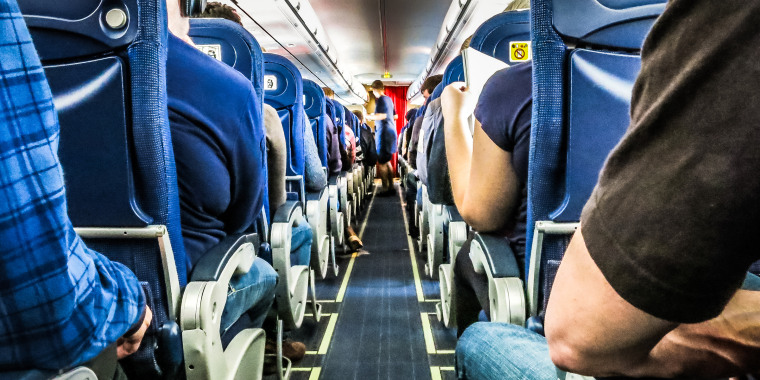With spring break travel season in full bloom, the coronavirus outbreak has people wondering if they should put their upcoming plans on hold.
The U.S. Centers for Disease Control and Prevention has been regularly updating its site to share the latest information about the spread of COVID-19, the disease caused by a member of the coronavirus family. This includes travel-related FAQs and how to keep your self safe from the disease.
While many people are postponing or canceling flight reservations or cruises, if you must travel, here is what you need to know to minimize your risk while traveling by plane during the current outbreak.
Exercise the same caution that you'd use on land.
Travelers should practice thorough hand-washing and avoid touching the face — just like they would on land.
The CDC reassures that because of how air is filtered and circulated on airplanes, most "viruses and other germs do not spread easily on airplanes."
However, passengers should still "avoid contact with sick passengers, wash hands often with soap and water for 20 seconds and use hand sanitizer that contains 60%-95% alcohol," advice that seems to be the standard when dealing with the outbreak.
The CDC has also released guidelines for crew members on how best to clean the plane between trips. What else can individuals passengers do to stay healthy?
Grab a window seat.
According to a study from Emory University, the best place to sit on a plane if you want to avoid germs as much as possible is the window seat because not as many germs circulate toward the windows of the plane.
If a sick passenger is on your flight, the CDC shared a graphic to help people understand the risk level of catching the disease depending on the infected passenger's location.

The four risk levels are high, medium, low and no identifiable risk. The latter three categories are the most applicable to airline travel.
People considered at medium risk are those who are seated within 6 feet of a traveler with symptomatic laboratory-confirmed COVID-19 infection. This distance is approximately two seats in each direction.
People considered at low risk are those who are seated within two rows of a sick traveler but not within 6 feet.
The risk levels also apply to situations beyond just airplanes or air travel.
The CDC says that high risk applies to anyone "living in the same household as, being an intimate partner of, or providing care for a person with symptomatic laboratory-confirmed COVID-19 infection in a nonhealthcare setting such as a home." It also applies to anyone who traveled from China's Hubei province.
Medium risk applies to anyone who had "close contact with a person with symptomatic laboratory-confirmed COVID-19."
It also applies to individuals who "live in the same household as, an intimate partner of, or caring for a person in a nonhealthcare setting (such as a home) to a person with symptomatic laboratory-confirmed COVID-19 infection while consistently using recommended precautions for home care and home isolation" as well as people who traveled from mainland China outside the Hubei Province.
Low risk applies to people who are in the "same indoor environment (e.g., a classroom, a hospital waiting room) as a person with symptomatic laboratory-confirmed COVID-19 for a prolonged period of time but not meeting the definition of close contact."
Low identifiable risk is any interactions — such as walking by or being in the same room briefly — with a person with symptomatic laboratory-confirmed COVID-19 infection that is not classified as high, medium or low risk.
Use disinfectant wipes — the right way.
Passengers should disinfect their area — including hard surfaces like the tray table, armrest, seat belt buckle, headrest, screen, remote and the seat pocket — with wipes.
Travelers should also note whether their seat is hard and nonporous or leather or pleather. These surfaces are fine to wipe down, however, if your seat is upholstered, that could lead to a wet seat and the "spreading of germs rather than killing them," according to The New York Times. But take care to hold a tissue while wiping down areas like touch screens to avoid any possible droplets from transferring to your hand and eventually to your face if you touch it.
The duration of wiping depends on the brand used; flyers should take a look at the time recommendations listed on the product — that could be anywhere from three to five minutes.
Or, you can take a cue from Naomi Campbell, who revealed her own plane-cleaning routine last July. At the time, the supermodel's in-depth sanitizing regimen was deemed excessive by some. But with the coronavirus outbreak in the headlines every day now, her cleaning ritual might not seem so outlandish after all.




